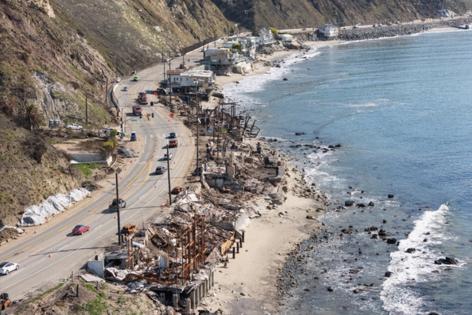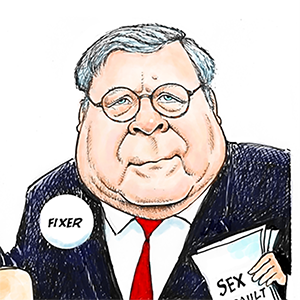Declaring Malibu's fire recovery a failure, city's rebuild ambassador quits and says mayor should go, too
Published in News & Features
LOS ANGELES — The slow pace of reconstruction after January’s fire disaster has touched off a political tempest in Malibu, prompting the resignation of the city’s volunteer rebuilding “ambassador” and his suggestion — along with some other rebuilding activists — that Mayor Marianne Riggins “consider gracefully stepping down.”
The controversy brings to a boil a conflict that has been simmering for months over what Malibu residents say are overly onerous rebuilding requirements. Some 720 structures in the city burned down in January, but just 69 have received initial plan approval and only two have obtained building permits, allowing them to begin construction.
That painfully slow progress provided the backdrop Monday, as rebuilding ambassador Abe Roy told the City Council he was resigning. “Our work is far from done,” Roy told the City Council. “Two permits issued in nearly 10 months is an abomination by any standard.”
Malibu is struggling to rebuild
Despite all the city’s apparent privilege, the truth is that many Malibu residents are struggling to rebuild. Some of them blame an understaffed city government and inflexibility among technical experts hired by the city under contract for things like geological reviews.
That both rich and poor areas can struggle to rebuild after wildfires is nothing new. The Los Angeles Times this week published an investigative series that showed how a middle-class neighborhood on flat land in Santa Rosa rebuilt many more homes than both rich and poor communities in other parts of the state.
In Malibu, some residents complain that they are afraid to even put their plans before the city’s building and safety department because of the demands for repeated fine-tuning and expensive technical studies. Homeowners have been asked to address slope challenges, soil stability, septic system functionality, along with water flow and street access for fire prevention.
There are roughly 700 burnt properties, including the family ranch house where I grew up in Carbon Canyon, which we had planned to sell sometime this year. (We have no reconstruction plans pending before the city.)
The rebuilding ambassador clashed with the mayor
Roy, a Malibu resident and professional builder, accused city officials of undermining him and questioning his ethics because some families paid him as a consultant to offer rebuilding advice before he took the unpaid ambassador position. Roy said in an interview he had never asked for, or received, any special favors for his clients.
He believes some in the city did not like a recent interview he gave to the Malibu Times, in which he said the city of Los Angeles was doing a better job reviewing plans for Pacific Palisades rebuilds. Some residents at Monday’s meeting also questioned whether the long hours of plan scrutiny were intentionally extended by contractors, in order to increase their billable hours, though city officials said there was no evidence of this.
Roy had been appointed by the City Council on May 21. Among his duties: “helping to remove administrative obstacles and enhancing community outreach.” The council said then it would consider later whether to extend his initial 90-day appointment as ambassador. Instead, he learned several days ago that the city intended to give him a commendation and thank him for a job well done, something council members said they never voted on.
Roy said it would have been a “betrayal” of his neighbors to end his role without discussing whether it should be extended to advance the reconstruction. When city leaders got wind of the furor over the end of Roy’s tenure, they removed the matter from Monday’s agenda. Instead, Roy strode to the podium and read his resignation statement.
Councilman Bruce Silverstein said he was “shocked” to learn that Roy’s post had effectively been ended without the full council’s discussion of the matter. “A majority of that council did not reach that decision,” Silverstein said. Councilwoman Haylynn Conrad also voiced distress, calling for more streamlining measures and saying it seemed like the city was showing more deference “to consultants and to a process” than to those who lost homes.
In an email Tuesday to the five-member City Council, Roy directly addressed Riggins, who is serving — as part of a regular rotation — as mayor. “Given the urgent need to better manage fire rebuilds and improve Malibu’s scorecard — acknowledge and take action to resolve process issues and hire a City Manager — you may consider gracefully stepping down and handing the mantle of leadership at this crucial time to someone adept at managing through crisis.” He said in an interview he believes Riggins should leave the council altogether, not just her post as mayor.
“I understand their anger and frustration, but I’m here to stay,” Riggins said in an interview Wednesday. “And I know that in my heart I’m the right person to be here at this time and to continue to do this work for all the residents of the city.”
Silverstein said in a subsequent interview that the entire council bore responsibility for not more quickly clarifying the rules to be applied to rebuilds and that it was not fair to single out Riggins alone. He also said that comparisons with the city of Los Angeles were illogical, because most homes there don’t face the geotechnical challenges presented by building on hillsides and the oceanfront.
Several residents blasted the city for its treatment of Roy. After the extended discussion, Riggins said she took “responsibility” for the situation. She acknowledged that she had discussed with City Manager Candace Bond that — though Roy had been an “asset” to the city — in the future she believed that concerns from the public could be forwarded to the council by “zone captains” representing each burned-out neighborhood. She said Roy would “not be precluded from taking part in any of those meetings.”
Fire reconstruction hits Malibu’s slow-growth ethos
The mayor also defended the city’s reconstruction work, saying it had taken many steps, while also acknowledging a need for “adjustments.” She added: “We’re going to make this better, and we’re going to get you back in your homes, and we have to be a team in order to do this.”
The city issued a statement Tuesday with a long list of actions taken to try to smooth the way for reconstruction. It included the opening of a “one-stop Rebuild Center” near City Hall, the waiver of permit fees and amending zoning and local coastal rules. The statement also thanked Roy, saying his “contributions reflect Malibu’s strong community spirit.”
City officials said at Monday’s meeting that they have been challenged by short staffing. The city is operating with only an interim city manager and is 15 employees short of full staffing in community development, Councilman Doug Stewart said.
Roy said the city may be at a more fundamental crossroads. Malibu incorporated in 1991, largely to prevent the installation of sewers and the rampant development residents feared would come with them. That slow-growth ethos has never abated, forcing even simple remodeling jobs to go through painstaking reviews, some residents complain.
“Because Malibu wants to be slow growth and they don’t want to have development,” plans get slow-walked to completion, said Roy, whose home in the Big Rock neighborhood survived the fire. “But that’s not going to work for these fire rebuilds.”
Riggins said she believes the city does not have to give up its past priorities to meet the needs of the moment.
“I think we can still be a slow-growth community and be respectful of managed development while still being able to move forward with urgency on rebuilding the homes that were lost in the fire,” the mayor said. “It’s been made very clear that disaster rebuilds are a priority.”
_____
©2025 Los Angeles Times. Visit at latimes.com. Distributed by Tribune Content Agency, LLC.







Comments